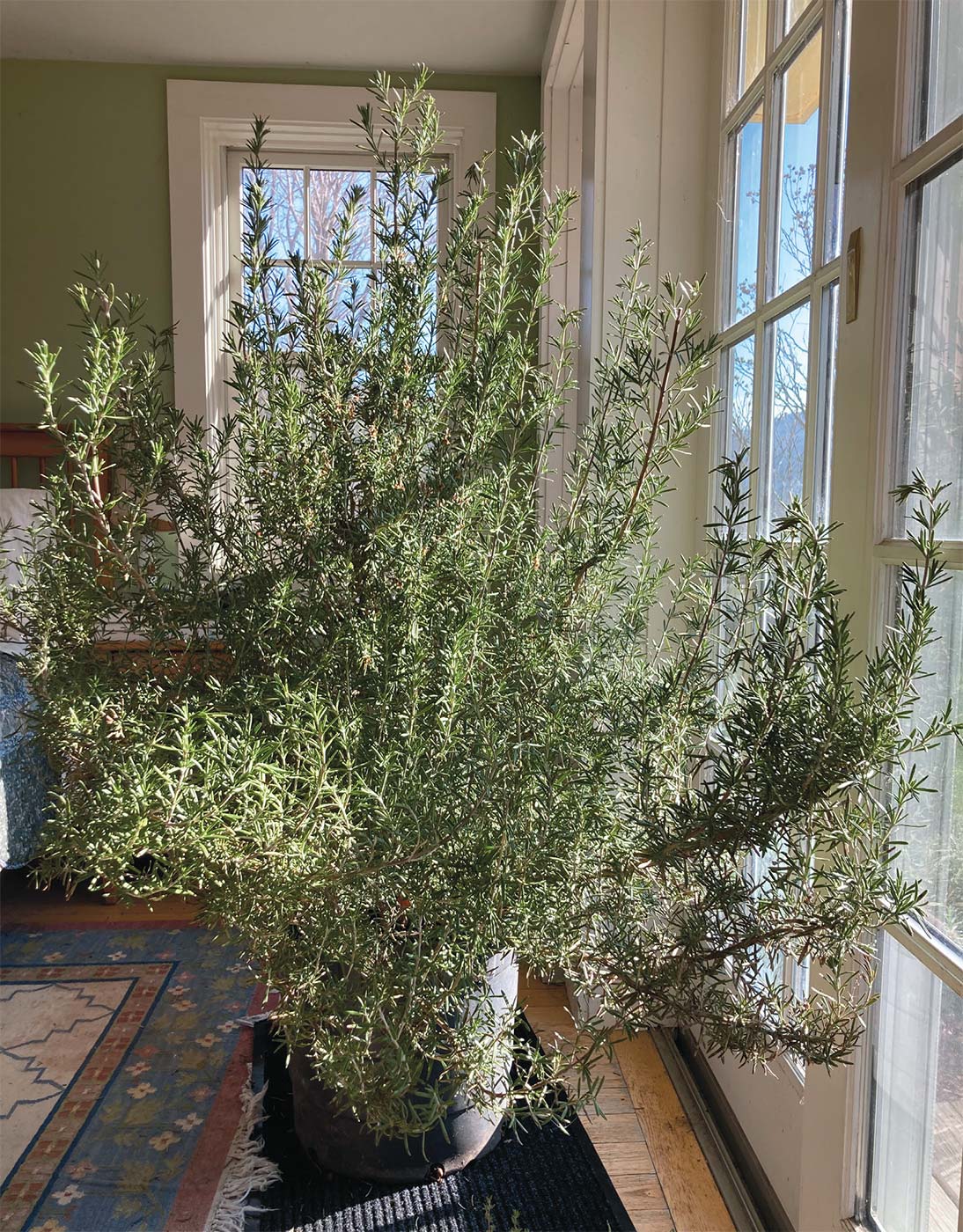Hail to Herbs
The once-scraggly little rosemary has flourished for five years now, withstanding its semi-annual uprooting and transition to winter and summer accommodations.

Maria‘s winter companion, a 5-foot tall rosemary plant she nurtures in a south-facing window
Nothing surpasses the crowning touch of fresh herbs from early summer through late fall.
Basil. Tarragon. Parsley. Oregano. Dill. Thyme. Rosemary. Sage. Cilantro.
These classic herbs can transform an average dish into something memorable. While we often reach for a jar of their dried versions during the winter months to enliven our cooking, nothing surpasses the crowning touch of fresh herbs from early summer through late fall.
Because I spend most of my working days from April through November on a farm, the last thing I want to do is come home and toil in a vegetable garden. However, I always plant an herb garden. Fresh herbs make me happy, and that joy infuses the meals I prepare.
Establishing an herb garden requires nothing more than a space to grow, good soil, and healthy starts from a local farm or garden center. Low effort, big results. You can start with a couple of small pots of herbs placed on a windowsill or porch. I’ve also popped two or three different herbs into a more substantial rectangular or round container destined for a deck. You can tuck a few plants into the front edge of an existing garden. Or, create a bed of any size and dedicate it exclusively to your herbs.
Experiment with different varieties of the same plant and plunk a few in various spots to see which thrives best where. I grow Tuscan Blue, Spice Island, and Arp rosemary; for thyme, I select common, French, German (or winter) thyme, and sometimes lemon thyme. Curly parsley appeals more to me than flat-leaf but I still grow both. And basil comes in an abundance of varieties. Beware when you plant sage, a hardy perennial that can endure for years: make sure you put it in a spot where it can thrive and expand undisturbed. Check out your local garden center or farm stand to see what they offer; the experts there can provide guidance on varieties and growing tips.
Location is also a consideration. I love having one herb bed right near my back entrance so I can sample a couple of leaves or smell their fragrance as I come and go. I have another small garden flanking the doors to our terrace where I’ll often linger at night before turning in, gazing at the stars and unconsciously running my hands through the lavender, sage, rosemary, and thyme. The aroma on my fingertips transports me to a deeper sleep.
I’m so crazy about fresh herbs that I nurture a now-massive rosemary plant in my bedroom during winter! Five years ago, a friend gave me a Charlie Brown–esque plant at the end of the growing season. Neither of us could bear to send it to the compost. The forlorn little plant stood maybe a foot tall, its gangly, desiccated branches a confused tangle. My bedroom faces south, which means winter sun floods the space, enough to sustain a hardy, tropical plant. I settled the pot near the window, tended it through winter (indoor rosemary prefers daily misting more than root watering), planted it in my garden the following spring, then dug it up that November and transferred it to a larger pot for hibernation indoors.
The once-scraggly little rosemary has flourished for five years now, withstanding its semi-annual uprooting and transition to winter and summer accommodations. It now soars to 5 feet tall and has grown so full that I had to harvest a load of branches to make it fit through the door! With those fragrant, lush green leaves, I made rosemary simple syrup, rosemary-infused gin, and a heady rosemary and garlic olive oil. Having an abundance of rosemary encourages me to put it to worthy use, so I roast my Sunday chicken on top of several aromatic wands, drop branches into soups and stews, and add chopped leaves to savory baked goods or marinades.
I added a trio of potted thyme plants to my bedroom winter garden; I like to think the rosemary appreciates her sisters clustered at her feet. Each morning, I spritz the plants and splash an occasional glass of water around their base if they look thirsty. They scratch my farming itch during winter, and it makes me giggle to harvest herbs from my bedroom for a meal.
Bottom line? If you don’t have the time, space, or inclination to maintain a vegetable garden but want to grow something fresh and delightful, consider herbs. You can go as small or large as you desire. From small potted herbs on a windowsill or deck to little pocket gardens to a more abundant, established bed or two, these culinary treasures will offer fragrance, provide beauty, enhance any meal, and bring joy every time you harvest or simply brush your hands through the lush plants. And that shower of herbs on your meal will add the crowning touch.




